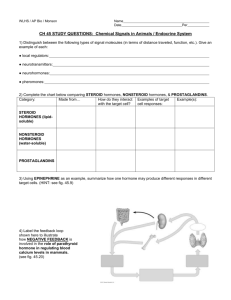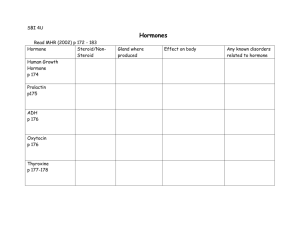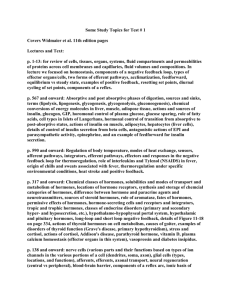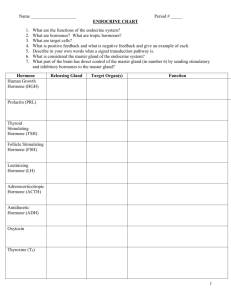Hormone Packet 08
advertisement
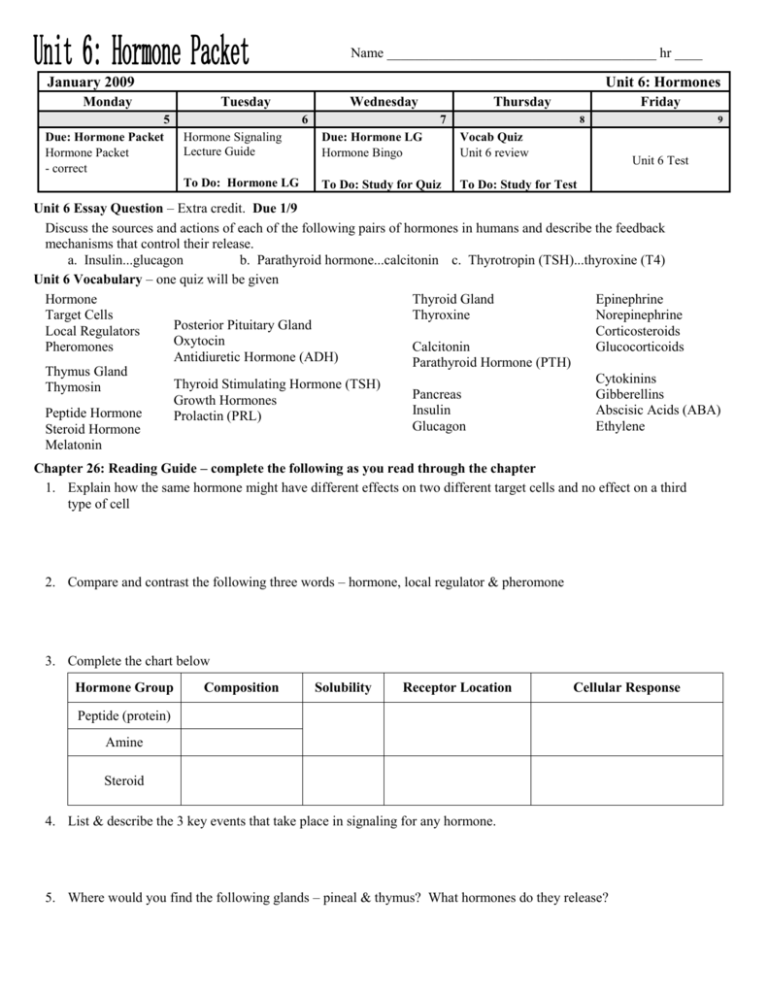
Name _______________________________________ hr ____ January 2009 Unit 6: Hormones Monday 5 Due: Hormone Packet Hormone Packet - correct Tuesday Wednesday 6 Thursday Friday 7 8 Hormone Signaling Lecture Guide Due: Hormone LG Hormone Bingo Vocab Quiz Unit 6 review To Do: Hormone LG To Do: Study for Quiz To Do: Study for Test 9 Unit 6 Test Unit 6 Essay Question – Extra credit. Due 1/9 Discuss the sources and actions of each of the following pairs of hormones in humans and describe the feedback mechanisms that control their release. a. Insulin...glucagon b. Parathyroid hormone...calcitonin c. Thyrotropin (TSH)...thyroxine (T4) Unit 6 Vocabulary – one quiz will be given Hormone Thyroid Gland Epinephrine Target Cells Thyroxine Norepinephrine Posterior Pituitary Gland Local Regulators Corticosteroids Oxytocin Pheromones Calcitonin Glucocorticoids Antidiuretic Hormone (ADH) Parathyroid Hormone (PTH) Thymus Gland Cytokinins Thyroid Stimulating Hormone (TSH) Thymosin Pancreas Gibberellins Growth Hormones Insulin Abscisic Acids (ABA) Peptide Hormone Prolactin (PRL) Glucagon Ethylene Steroid Hormone Melatonin Chapter 26: Reading Guide – complete the following as you read through the chapter 1. Explain how the same hormone might have different effects on two different target cells and no effect on a third type of cell 2. Compare and contrast the following three words – hormone, local regulator & pheromone 3. Complete the chart below Hormone Group Composition Solubility Receptor Location Cellular Response Peptide (protein) Amine Steroid 4. List & describe the 3 key events that take place in signaling for any hormone. 5. Where would you find the following glands – pineal & thymus? What hormones do they release? 6. Posterior Pituitary Gland a. Composed of: b. List the two hormones it produces 7. Anterior Pituitary Gland a. Composed of: b. List the hormones it produces 8. Explain how the hypothalamus controls body functions through its action on the pituitary gland. How does control on the anterior and posterior pituitary gland differ? 9. How does the Thyroid Gland help regulate your metabolism? 10. What is the role of Ca+ ions in the body? 11. What are antagonistic hormones? Use the hormones Calcitonin and Parathyroid Hormone (PTH) in your explanation a. What are the two antagonistic hormones secreted by the pancreas 12. Diabetes mellitus a. Definition b. What is the difference between Type 1 and Type 2 13. What hormones are responsible for the ‘fight or flight’ response? a. Where specifically would you find them? 2 14. What hormones are released by the ovaries? Testes? 15. Complete the chart of hormone (these should also be memorized, use page 523 for help) Class of Hormone Released from Action taken Hormone Adrenocorticotropic Hormone (ACTH) Androgens Antidiuretic Hormone (ADH) Calcitonin Corticosteroids Epinephrine Estrogens Follicle stimulating Hormone (FSH) Glucagon Glucocorticoids Growth Hormones Insulin Luteinizing Hormone (LH) Melatonin Mineralocorticoids Norepinephrine Oxytocin Parathyroid Hormone (PTH) Progesterone Prolactin (PRL) Thymosin Thyroid Stimulating Hormone (TSH) Thyroxine 3 16. In the picture label a. b. c. d. e. f. g. h. i. j. k. l. m. Take notes on the following: (also located on the school website) o G Protein Signaling http://en.wikipedia.org/wiki/G_protein o Watch animation & note the steps for the intracellular transduction and cellular response (gProtein and IP3) http://www.youtube.com/watch?v=DGkh7SGacgk or http://www.youtube.com/watch?v=bU4955rLv_8 o Cyclic Amp: http://fig.cox.miami.edu/~lfarmer/BIL265/CAMP.HTM o At http://en.wikipedia.org/wiki/Main_Page look up: Tyrosine Kinase, Calmodulin & IP3 4 Section 33.1 Use the experiments of Darwin and Boysen-Jensen to answer these questions and to fill in the data table below. You will have to use your own brain as the text may not give you all the answers. 1. What questions were they trying to answer? 2. What was their hypothesis? 3. Method in the experiment: a. What did they change? b. What did they measure? c. What did they keep the same? d. What was their control? 4. Data table – fill in-use figure 33.1C (results key: s=straight, ct=curve to light, ca=curve away from light) Treatment Resulting growth 5. What was their conclusion Use sections 33.1–33.7 to complete the table below Plant Hormone Place of action Where made and released? What is the action? Interacts with what hormones? 5 1. How are hormones distributed to tissues, and what determines which cells a hormone will affect? a. They are distributed in the interstitial fluid and affect nearby responsive target cells. b. They are carried to specific organs by lymphatic vessels and affect the cells in those organs. c. They are delivered by neurosecretory cells to specific tissues and cells, which are affected. d. They are carried in bloodstream of the body & each hormone affects the target cells responsive to it. e. They are carried to specific organs by ducts and affect the cells in those organs. 2. Hormones regulate a. Metabolism. d. Water balance b. Growth. e. All are correct c. Reproduction. 3. Steroid hormones are made from a. Carbohydrates. d. Cholesterol b. Amino acids. e. Nucleic Acids c. Carbohydrates & amino acids. 4. Why do some hormones bind to a plasma-membrane receptor to activate a target cell? a. They are not water-soluble. b. They cannot cross cell membranes. c. They require activation by ATP. d. They bind to too many types of cells. e. None of the choices are correct. 5. Which of the following hormones is released by a neurosecretory cell? a. Oxytocin d. Insulin b. Calcitonin e. Estrogen c. Growth hormone 6. Which of the following hormones affects the greatest variety of cell types? a. Endorphine d. Growth Hormone b. Prolactin e. Calcitonin c. Melatonin 7. Which gland requires the element iodine to produce its hormones? a. thyroid d. pituitary b. adrenal medulla e. pineal c. ovary 8. Which of the following pairs of hormones have opposite effects? a. testosterone and melatonin b. parathyroid hormone and calcitonin c. FSH and LH d. oxytocin and prolactin e. progesterone and insulin 9. Which of the following best describes the relationship of insulin to glucagon? a. High levels of insulin inhibit secretion of glucagon. b. They are antagonistic hormones. c. Insulin is a steroid hormone; glucagon is a protein hormone. d. Work together to prepare the body to deal with stress. e. Insulin stimulates the pancreas to secrete glucagon. 1 2 3 4 5 6 7 8 9 10. Which of the following glands secretes hormones that enable the body to respond to stress? a. adrenal d. salivary b. pancreas e. parathyroid c. pineal 11. Which of the following is not a function of epinephrine? a. increased breathing rate b. increased heart rate c. increase in blood pressure d. increase absorption of glucose by the digestive tract e. release of glucose from the liver 12. Which of the following types of hormones mediates the phototropic responses of shoots? a. cytokinins d. abscisic acid b. auxins e. gibberellins c. ethylene 13. Four of the five classes of plant hormones affect development (cell differentiation). Which one does not? a. abscisic acid d. gibberellins b. auxins e. ethylene c. cytokinins 14. If the auxin that is produced by an apical meristem coming out of winter dormancy is conveyed equally down all sides of a twig, the twig will probably a. develop fruit. d. flower. b. branch near its tip. e. shorten c. elongate. 15. When a nursery worker pinches off the terminal buds on a young chrysanthemum plant to make it grow bushy, which of the following plant hormones is mainly responsible for stimulating branching? a. ethylene b. an auxin c. abscisic acid d. a gibberellin e. a cytokinin 16. Which of the following hormones is/are produced in the apical meristems of shoots and roots? a. ethylene b. gibberellins c. auxins d. abscisic acid e. cytokinins 17. What prevents a seed released in the fall from germinating immediately? a. shortening day length b. abscisic acid c. gibberellins d. the need to be frozen before it can germinate e. falling temperatures 18. Most plant hormones act as promoters of one response or another. Which type of hormone is unusual in that it generally acts as a growth inhibitor? a. gibberellins b. ethylene c. cytokinins d. abscisic acid e. auxins 10 11 12 13 14 15 16 17 18



